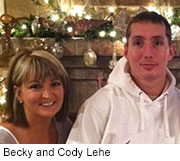
WEDNESDAY, Jan. 2 (HealthDay News) — After taking a hard hit to the head during a football game, an Indiana high school student suffered severe headaches for the next three days. Following a head CT scan that was normal, his doctor told him to wait to go back on the field until he felt better.
But the boy returned to practice, where he suffered a devastating brain injury called second impact syndrome.
More than six years later, Cody Lehe, now 23, is mostly wheelchair-bound and struggles with diminished mental capacity. Yet he’s fortunate to be alive: Second impact syndrome is fatal in about 85 percent of cases.
“It’s a unique syndrome of brain injury that appears in high school and younger athletes when they have a mild concussion, and then have a second head impact before they’re over the symptoms of their first impact. This leads to massive brain swelling almost immediately,” said Dr. Michael Turner, a neurosurgeon at Goodman Campbell Brain and Spine at the Indiana University School of Medicine, and co-author of a new report on Cody’s case, published Jan. 1 in the Journal of Neurosurgery: Pediatrics.
The case study illustrates why it’s so important to prevent a second impact and give a young brain the chance to rest and recover, another expert said.
“Second impact syndrome is a very rare phenomenon. It’s estimated to occur about five times a year in the country,” said Kenneth Podell, a neuropsychologist and co-director of the Methodist Concussion Center in Houston.
“What makes this [study] unique: They’re the first ones to actually have a CT scan after the first hit. What they were able to show is that the first CT scan was read as normal,” said Podell, who also is a team consultant for the Houston Texans, of the NFL. “After the first concussion there was no evidence of any significant injury. And then following the second one is when they ran into all of the problems.”
During the Friday night game, Cody told a teammate the first hit was the hardest he had ever taken and his head hurt and he felt dazed. But he downplayed symptoms to his parents, coaches and trainer.
“I think he was telling them what he was telling us,” his mother, Becky, said. “In those days, to have a concussion, if you weren’t vomiting or wanting to go to sleep or have blurred vision or all that kind of stuff, then you didn’t have a concussion. He didn’t have any of those symptoms; other than the headache, everything else was OK. And he told them, ‘I just need to go home and lie down and I’ll be all right.”
The intermittent headaches, however, were bad enough that he finally asked to see a doctor.
“The doctor did say, ‘Your scan is fine, but anytime you have a headache like that you probably shouldn’t play,'” Becky recalled. “It was the first week of sectionals, and we won the first round. [Cody] was the captain, so he said, ‘I’m not going to stay on the sidelines. I’ve had headaches like this before. And if the scan says I’m fine, I’m playing.'”
The follow-up injury occurred during Tuesday afternoon practice.
“The second hit, which was very, very minor; we’re even reluctant to call it a ‘hit’ because it was a really light practice, and they weren’t even in full pads,” Becky said. “It was just kind of shoulder brushing and he was down.”
Turner said, “After his second impact, he says, ‘I really feel bad,’ and went to the side and said, ‘I can’t feel my legs,’ and collapsed. That quote is incredibly common in most of the case reports of this.”
During Cody’s hospitalization, he had complications including kidney failure, sepsis and pneumonia. It was 98 days before he came home.
Today Cody has a great sense of humor but struggles in other ways, Becky said. “His memory is terrible. His long-term is still there — if he met you once, he remembers you — but the short-term is really bad and it’s really hard to build on things when you can’t remember what you did 10 to 15 minutes ago.”
Cody has worked his way up to six minutes on a treadmill, and can stand up and walk, but he needs someone by his side because his balance is poor.
From this case, Turner said, other parents “can take away that this concussion stuff is serious — it’s not malingering. This is why we have impact testing and … all that stuff about keeping athletes out — because of the fear of this.”
In July 2012, an Indiana law went into effect mandating that high school student athletes suspected of having a concussion or head injury be removed from play and not return until they have been evaluated by a health care provider and given written clearance.
More information
Visit the U.S. Centers for Disease Control and Prevention to learn about concussions in sports.

